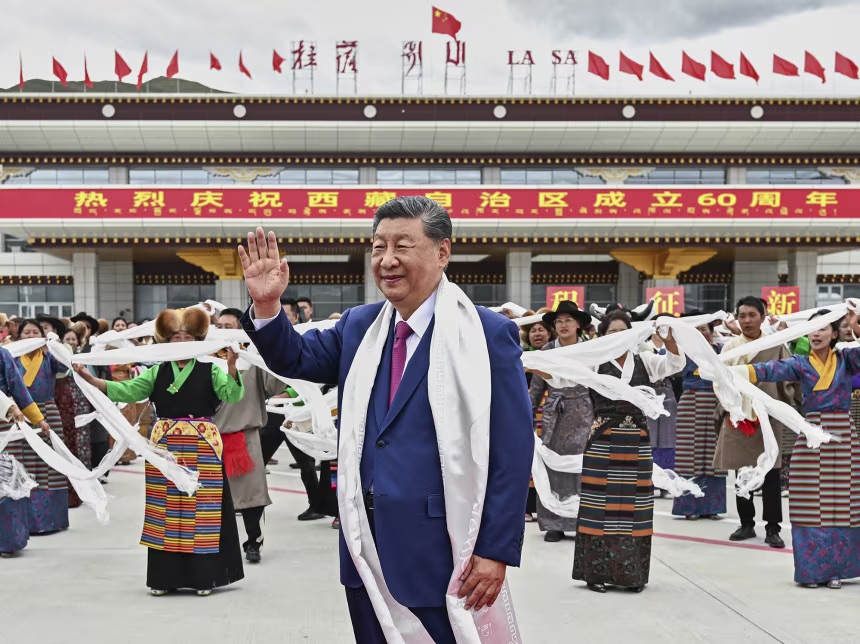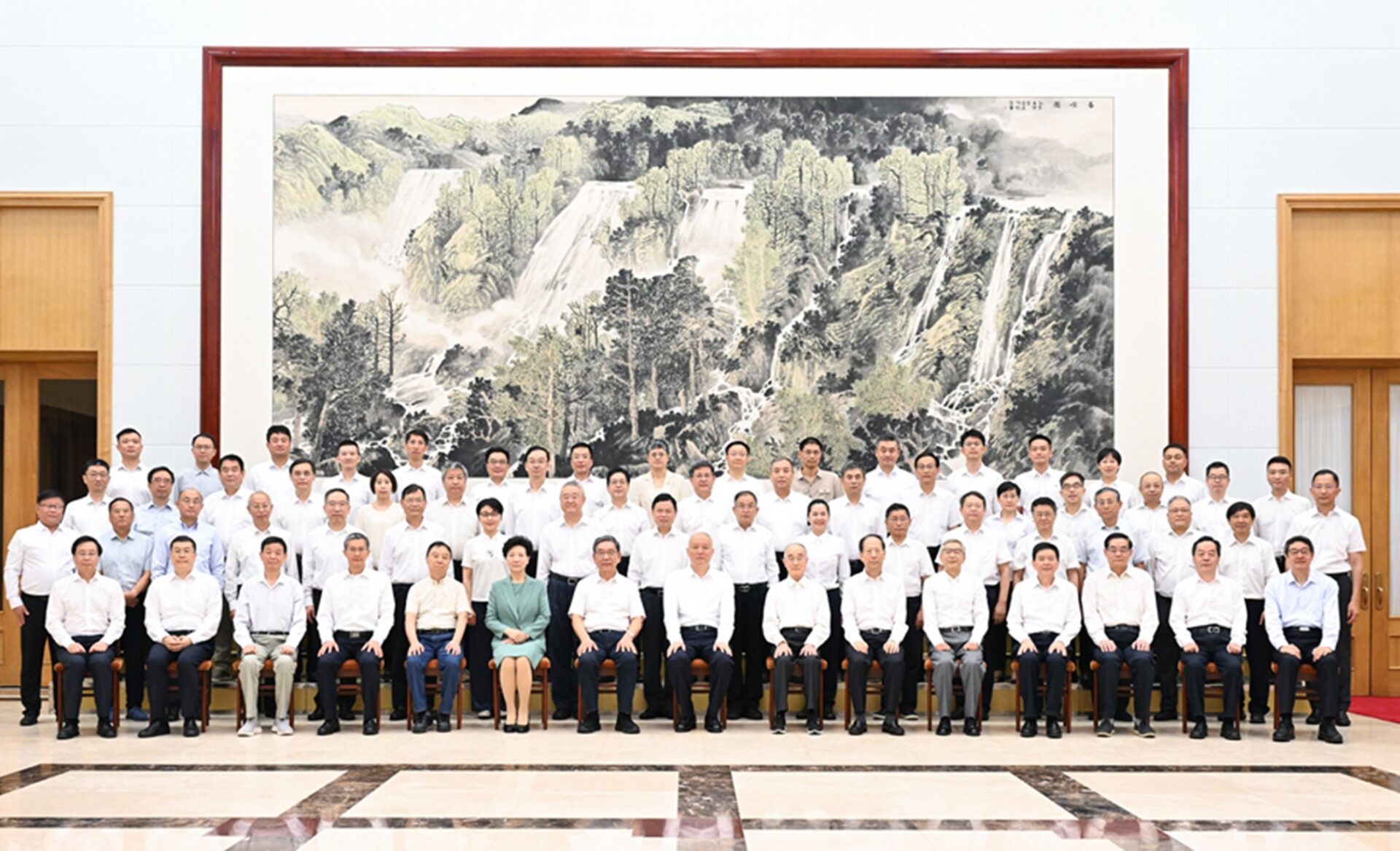
Military Implications of PLA Aircraft Incursions in Taiwan’s Airspace 2024
Military Implications of PLA Aircraft Incursions in Taiwan’s Airspace 2024
Executive Summary:
- In 2024, the number of days and sorties involving Chinese military aircraft crossing the Taiwan Strait median line reached a peak, but the total sorties of Chinese aircraft around Taiwan and the number of peak incursion periods were not significantly higher than in 2023.
- While the number of Chinese military aircraft incursions into Taiwan’s airspace has surged, the operational capacity of the PLA Eastern Theater Command Air Force is likely already at its maximum peacetime readiness level.
- The sharp increase in Chinese military aircraft incursions targeting Taiwan is not solely aimed at President Ching-te Lai but also reflects changes in the scope and intensity of the PLA’s training and exercises around Taiwan.
- Unless new airbases are constructed or logistical support capabilities are significantly improved within the PLA Eastern Theater Command, the number of sorties into Taiwan’s airspace is unlikely to increase substantially in 2025.
Incursions by military aircraft from the People’s Republic of China (PRC) into Taiwan’s Air Defense Identification Zone (ADIZ) reached unprecedented levels in 2024. Beyond measuring the total number of sorties, the frequency of these incursions and the circumstances surrounding specific missions are also important for assessing the characteristics and implications of People’s Liberation Army (PLA) aircraft activities targeting Taiwan. This article utilizes publicly available data on PLA aircraft operations released by Taiwan’s Ministry of National Defense.
In 2024, the overall number of sorties and days on which incursions took place continued to rise. However, the percentage of sorties crossing the median line in the Taiwan Strait and the frequency of peak incursion periods were not markedly higher than those in 2023. This suggests two things. First, the operational capacity of the PLA’s Eastern Theater Command Air Force, which is mainly focused on Taiwan, may have reached its limits; and second, the intensified incursions against Taiwan were conducted not solely to target President Lai Ching-te (賴清德) but also to increase the intensity of trainings.
Incursions by Chinese Military Aircraft
We use three indicators to analyze the incursions: the frequency of crossings over the Taiwan Strait median line, the number of sorties crossing the median line as a percentage of the total, and the number of peak incursion periods.
Crossings of the Median Line at Record High
Chinese military aircraft crossed the median line on more days in 2024 than in any other calendar year on record. (Taiwan’s Ministry of National Defense began releasing this data in September 2020.) This figure has risen in the last four years, from 240 crossings in 2021 to 269 in 2022, 271 in 2023, and 313 in 2024. A look at the monthly totals reveals that, in nine of the twelve months of 2024, Chinese aircraft crossed the median line on more days than in the preceding three years (see Figure 1).
Figure 1: Monthly Days of Chinese Aircraft Crossing the Taiwan Strait Median Line
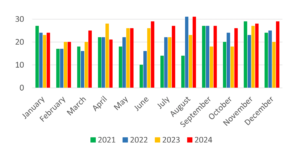
(Source: Compilation by RCDA Based on ROC MND Press Releases)
Second, in 2024, Taiwan’s Ministry of Defense recorded the highest annual number of sorties by PLA aircraft crossing the Taiwan Strait median line since 2021. The annual totals were 953 sorties in 2021, 1,732 in 2022, 1,703 in 2023, and 3,070 in 2024. A further examination of the monthly figures shows that 2024 had the highest monthly totals in eight out of twelve months compared to previous years (see Figure 2).
Figure 2: Monthly Sorties of Chinese Aircraft Crossing the Taiwan Strait Median Line
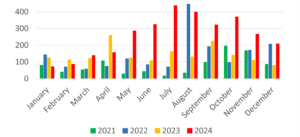
(Source: Compilation by RCDA Based on ROC MND Press Releases)
Third, the daily average number of PLA sorties crossing the median line was also higher in 2024 than in any year since 2021. When calculated by dividing the total number of sorties by the number of days with median line crossings, the daily averages were 3.9 sorties in 2021, 5.9 in 2022, 4.7 in 2023, and 8.4 in 2024. [1] A closer examination of the monthly averages reveals that 2024 had the highest monthly averages in nearly every month compared to previous years, as shown in Figure 3.
Figure 3: Monthly Average Sorties of Chinese Aircraft Crossing the Taiwan Strait Median Line
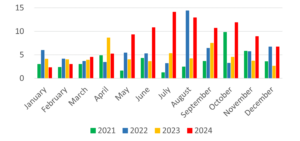
(Source: Compilation by RCDA Based on ROC MND Press Releases)
Significant Increase in Percentage of Median Line Crossings
PLA aircraft crossing the median line represents a political violation of a long-standing tacit agreement dividing the two sides of the strait. It also poses a significant military threat. The closer these incursions come to Taiwan, the further the reaction and interception time for Taiwan’s Air Force is reduced. This exerts greater military pressure on Taiwan while simultaneously depleting its air force’s operational readiness. Regardless of whether these aircraft belong to the Eastern Theater Command Air Force or are transiting from other theater commands, they predominantly use the airbases and resources of the Eastern Theater Command and operate under its command and control for activities in and around the Taiwan Strait.
Starting in August 2022, Taiwan’s Ministry of National Defense has reported the total number of PLA aircraft detected in the airspace surrounding Taiwan, including both those crossing the median line and those operating west of the median line or around Taiwan’s ADIZ. Two trends emerge from analysis of this data alongside the data on aircraft crossing the median line.
First, unlike the sharp increase in the number of sorties crossing the median line, the total number of Chinese military aircraft detected by Taiwan in 2024 did not rise significantly compared to 2023. In 2023, Taiwan detected a total of 4,711 sorties, while in 2024, the figure was 5,105. This represents an increase of 394 sorties, which is relatively modest—the 1,367 additional sorties that crossed the median line in 2024, indicating that the increase in median line crossings is nearly three times the total increase in sorties. As a result, the number of detected sorties crossing the median as a percentage of total detected sorties rose significantly, from 36.1 percent in 2023 to 60.1 percent in 2024, as shown in Table 1.
Table 1: Comparison of the Proportion of Chinese Aircraft Crossing the Taiwan Strait Median Line
| Year | Total Detected Sorties | Sorties Crossing the Median Line | Percentage of Sorties Crossing the Median Line |
| 2023 | 4,711 | 1,703 | 36.1% |
| 2024 | 5,105 | 3,070 | 60.1% |
(Source: Compilation by RCDA Based on ROC MND Press Releases)
Second, the number of days in 2024 when over half of detected Chinese military aircraft crossed the median line was much higher than in 2023. While such instances were relatively rare in 2023, occurring on only 62 days throughout the year, in 2024 these situations became almost routine, occurring on 209 days. This heightens the demand placed on Taiwan’s defensive measures, as it requires a more robust response. For every two detected Chinese aircraft, Taiwan likely needs to prepare one of its own for a potential response or interception, as one of the two Chinese aircraft is likely to cross the median line. Notably, starting in April 2024, on most days over half of the detected Chinese aircraft crossed the median line, as shown in Figure 4.
Figure 4: Daily Percentage of Chinese Aircraft Crossing the Median Line
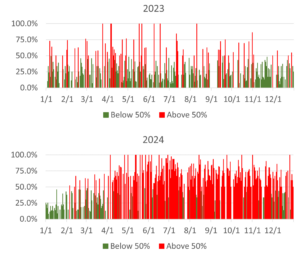
(Source: Compilation by RCDA Based on ROC MND Press Releases)
Frequency of Peak Incursions: No Significant Increase
Peak incursion periods are instances where the number of Chinese military aircraft entering Taiwan’s ADIZ exceeds a certain threshold, causing greater-than-usual pressure on Taiwan through their coercive capacity. In this case, we define the threshold as at least 30 aircraft. This is equivalent to roughly one-tenth of Taiwan’s fleet of approximately 300 main fighter aircraft, which includes F-16s, IDFs, and Mirage 2000s. It is practically impossible for every aircraft and its corresponding pilot to be in a state of readiness for immediate deployment and factors such as mechanical issues, scheduled maintenance, equipment upgrades, and personnel rotations limit full operational readiness. This threshold represents a scenario where each of Taiwan’s five Tactical Fighter Wings would need to scramble six aircraft in response.
Under this criterion, there were 28 peak incursion days in 2023 and 32 in 2024. This modest increase of only four days contrasts with the upsurge in the total number of PLA aircraft incursions, as shown in Figure 5 and 6.
Figure 5: Daily Activities of Chinese Military Aircraft Around Taiwan’s Surrounding Airspace
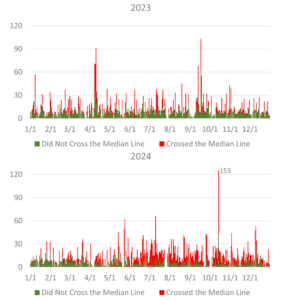
(Source: Compilation by RCDA Based on ROC MND Press Releases)
Figure 6: Monthly Count of Peak Incursion Periods
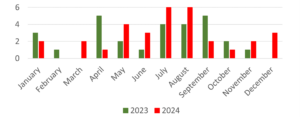
(Source: Compilation by RCDA Based on ROC MND Press Releases)
Military Implications
Two military implications stand out from the data on Chinese military aircraft incursions into Taiwan’s ADIZ over the years. These relate to the PLA’s operational capacity and the intensification of its training drills.
First, the operational capacity of the Eastern Theater Command Air Force is likely already at its maximum peacetime readiness level. This can be inferred from the overall number of military aircraft detected around Taiwan and the limited increase in peak incursion days. While the number of PLA aircraft crossing the Taiwan Strait median line has risen significantly, the total number of Chinese military aircraft detected around Taiwan has not increased proportionally. This suggests that the noticeable rise in incursions is not due to a surge in the total number of aircraft but rather an increase in the percentage of aircraft crossing the median line. Meanwhile, the minimal increase in the number of peak incursion days indicates that the rise in the annual total of median-line crossings is a result of an increase in the number of days on which incursions take place rather than an increase in high-intensity events on specific days. This implies that Taiwan faces a growing and persistent daily aerial threat from the PRC, rather than sporadic, deliberate actions on specific occasions.
National reunification remains a primary operational focus and training objective for the PLA. With the PRC’s overall military budget increasing annually, the PLA Air Force likely has more funding and resources available for training and patrol operations around Taiwan. This should logically lead to a rise in the total number of aircraft sorties. However, the lack of increase to the total number of sorties by Chinese military aircraft around Taiwan in 2024 on the scale seen the previous year may indicate that the Eastern Theater Command Air Force has reached a certain limit in its command and control, logistics, and equipment maintenance capacity. This could explain why, even with additional budget and resources, the number of sorties around Taiwan has not grown significantly.
The lack of an increase in the number of peak incursion periods aligns with this thesis. Chinese airbases typically maintain routine stockpiles of fuel and munitions and schedule logistics personnel for standard operations. Peak incursion periods require greater personnel coordination, resource allocation, and advance planning than normal operations, often necessitating staff recalls or canceling leave as well as the pre-positioning and stockpiling of equipment and fuel. As such, peak periods place significant strain on the operational capacity of the Eastern Theater Command Air Force. If this capacity is insufficient, the number of peak operations that can be executed will inevitably be limited.
Second, the sharp increase in Chinese military aircraft incursions targeting Taiwan reflects changes in the scope and intensity of the PLA’s training and exercises around Taiwan. They are not solely intended to respond to the words or actions of President Lai Ching-te. The incursions into Taiwan’s ADIZ serve multiple purposes: politically, they aim to pressure the Lai Administration; psychologically, they seek to instill fear within Taiwanese society; and militarily, they enhance the PLA’s operational capabilities. When PLA aircraft cross the Taiwan Strait median line, they engage in training drills, combat readiness patrols, or military exercises. In response, Taiwan’s Air Force conducts countermeasures and interceptions, providing the PLA Air Force with opportunities to train combat skills, familiarize themselves with the battlefield environment, and strengthen their experience in joint operations.
In 2023, the percentage of PLA aircraft crossing the median line was relatively low, indicating that many trainings or exercises took place outside Taiwan’s ADIZ or over mainland PRC airspace, limiting their realism without engagement from Taiwan’s Air Force. In contrast, in 2024, the majority of Chinese aircraft detected near Taiwan crossed the median line, meaning more aircraft were subjected to realistic operational scenarios. This shift reflects a deliberate effort by the PRC in 2024 to increase the intensity of its air force training drills.
There are several pieces of supporting evidence that point to this intensification being part of a predetermined plan. First, the surge in peak incursion periods began in April, not after President Ching-te Lai’s inauguration in May. This suggests the intensification was not directly tied to Lai’s presidency. Second, no peak incursion periods occurred in January 2024, likely due to Xi Jinping’s deliberate efforts to avoid provoking anti-China sentiment among Taiwanese voters during Taiwan’s presidential election. Following the election, February and March 2024 recorded 10 peak incursion periods, a number comparable to the 11 peak periods recorded during the same months in 2023. Third, the months from January through March marked the early implementation phase of the PRC’s annual training plan. During this period, PLA Air Force units likely needed to adjust to changes in the 2024 training agenda and prepare for increased training intensity, making the lack of a significant rise in peak periods during February and March compared to the same period in 2023 plausible.
Conclusion
Incursions by Chinese military aircraft into Taiwan’s ADIZ were more intense in 2024 than in previous years. They did not take place solely in response to the election of President Lai Ching-te but reflected an effort to enhance the training intensity of the PLA Air Force.
The Eastern Theater Command Air Force may not substantially increase the number of sorties into Taiwan’s airspace in 2025 unless new airbases are constructed or logistical support capabilities are enhanced to address current operational capacity limits.
Incursions into Taiwan’s airspace during January, February, November, and December 2025 may reveal patterns in PLA activity. The PLA’s annual training schedule typically emphasizes basic training in January and February, while November marks the completion of most annual training plans. As a result, the scale and frequency of activities during these months are lower than in other periods, which explains the relatively fewer incursions during these specific months.
This pattern may be changing, however. The scale of Chinese military aircraft incursions into Taiwan’s airspace in November and December 2024 was significantly larger than the typical monthly levels observed from 2021 to 2023. This suggests two possibilities. First, the Eastern Theater Command Air Force’s 2024 annual training plan may have included a substantial number of trainings near Taiwan during November and December. Second, the Eastern Theater Command Air Force may have continued patrols or even combat readiness patrols around Taiwan even after completing its 2024 training plan. Both scenarios indicate an effort by the PLA to break the previous pattern of lower operational activity at the beginning and end of the year, aiming to enhance the Air Force’s winter combat capabilities.
The views expressed are solely those of the authors and do not represent the positions of the National Defense University, the Ministry of National Defense, or the government of ROC (Taiwan).
Notes
[1] For more analysis on the proportion of Chinese aircraft crossing the Taiwan Strait median line, see The Diplomat, December 7, 2024.

